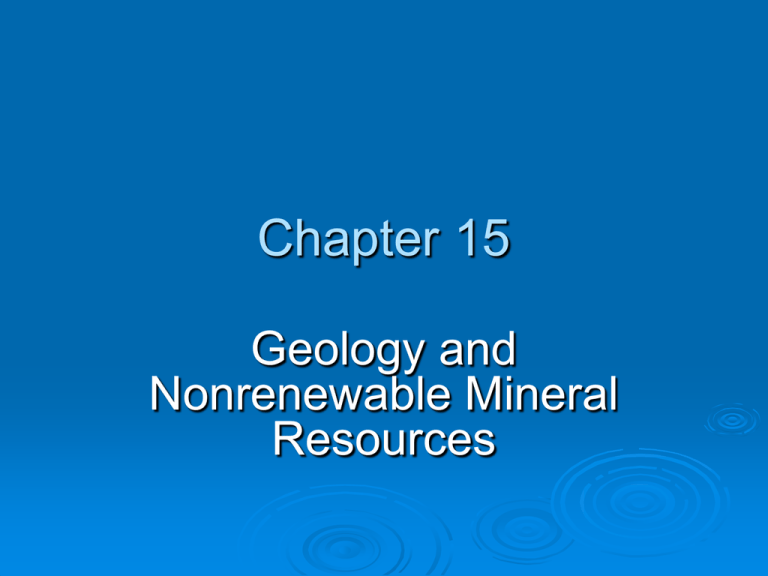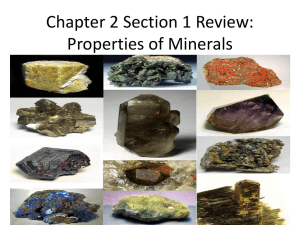Nonrenewable Mineral Resources
advertisement

Chapter 15 Geology and Nonrenewable Mineral Resources Chapter Overview Questions What are nonrenewable mineral resources and where are they found? How do we find and extract mineral resources from the earth’s crust, and what harmful environmental effects result from removing and using these minerals? Chapter Overview Questions (cont’d) Will there be enough nonrenewable mineral resources for future generations? Can we find substitutes for scarce nonrenewable mineral resources? How can we shift to more sustainable use of nonrenewable mineral resources? MINERALS, ROCKS, AND THE ROCK CYCLE The earth’s crust consists of solid inorganic elements and compounds called minerals that can sometimes be used as resources. Mineral resource: is a concentration of naturally occurring material in or on the earth’s crust that can be extracted and processed into useful materials at an affordable cost. General Classification of Nonrenewable Mineral Resources The U.S. Geological Survey classifies mineral resources into four major categories: Identified: known location, quantity, and quality or existence known based on direct evidence and measurements. Undiscovered: potential supplies that are assumed to exist. Reserves: identified resources that can be extracted profitably. Other: undiscovered or identified resources not classified as reserves General Classification of Nonrenewable Mineral Resources Examples are fossil fuels (coal, oil), metallic minerals (copper, iron), and nonmetallic minerals (sand, gravel). Figure 15-7 GEOLOGIC PROCESSES Deposits of nonrenewable mineral resources in the earth’s crust vary in their abundance and distribution. A very slow chemical cycle recycles three types of rock found in the earth’s crust: Sedimentary rock (sandstone, limestone). Metamorphic rock (slate, marble, quartzite). Igneous rock (granite, pumice, basalt). Rock Cycle Figure 15-8 ENVIRONMENTAL EFFECTS OF USING MINERAL RESOURCES The extraction, processing, and use of mineral resources has a large environmental impact. Figure 15-9 Natural Capital Degradation Extracting, Processing, and Using Nonrenewable Mineral and Energy Resources Steps Environmental effects Mining Disturbed land; mining accidents; health hazards, mine waste dumping, oil spills and blowouts; noise; ugliness; heat Exploration, extraction Processing Use Solid wastes; radioactive material; air, water, and soil pollution; noise; safety and health hazards; ugliness; heat Transportation or transmission to individual user, eventual use, and discarding Noise; ugliness; thermal water pollution; pollution of air, water, and soil; solid and radioactive wastes; safety and health hazards; heat Transportation, purification, manufacturing Fig. 15-10, p. 344 ENVIRONMENTAL EFFECTS OF USING MINERAL RESOURCES Minerals are removed through a variety of methods that vary widely in their costs, safety factors, and levels of environmental harm. A variety of methods are used based on mineral depth. Surface mining: shallow deposits are removed. Subsurface mining: deep deposits are removed. Open-pit Mining Machines dig holes and remove ores, sand, gravel, and stone. Toxic groundwater can accumulate at the bottom. Figure 15-11 Area Strip Mining Earth movers strips away overburden, and giant shovels removes mineral deposit. Often leaves highly erodible hills of rubble called spoil banks. Figure 15-12 Contour Strip Mining Used on hilly or mountainous terrain. Unless the land is restored, a wall of dirt is left in front of a highly erodible bank called a highwall. Figure 15-13 Mountaintop Removal Machinery removes the tops of mountains to expose coal. The resulting waste rock and dirt are dumped into the streams and valleys below. Figure 15-14 Mining Impacts Metal ores are smelted or treated with (potentially toxic) chemicals to extract the desired metal. Figure 15-15 SUPPLIES OF MINERAL RESOURCES The future supply of a resource depends on its affordable supply and how rapidly that supply is used. A rising price for a scarce mineral resource can increase supplies and encourage more efficient use. SUPPLIES OF MINERAL RESOURCES Depletion curves for a renewable resource using three sets of assumptions. Dashed vertical lines represent times when 80% depletion occurs. Figure 15-16 Production A Mine, use, throw away; no new discoveries; rising prices Recycle; increase reserves by improved mining technology, higher prices, and new discoveries B Recycle, reuse, reduce consumption; increase reserves by improved mining technology, higher prices, and new discoveries C Present Depletion Depletion Depletion time A time B time C Time Fig. 15-16, p. 348 SUPPLIES OF MINERAL RESOURCES New technologies can increase the mining of low-grade ores at affordable prices, but harmful environmental effects can limit this approach. Most minerals in seawater and on the deep ocean floor cost too much to extract, and there are squabbles over who owns them. Getting More Minerals from the Ocean Hydrothermal deposits form when mineral-rich superheated water shoots out of vents in solidified magma on the ocean floor. Figure 15-17 USING MINERAL RESOURCES MORE SUSTAINABLY Scientists and engineers are developing new types of materials as substitutes for many metals. Recycling valuable and scarce metals saves money and has a lower environmental impact then mining and extracting them from their ores. Solutions Sustainable Use of Nonrenewable Minerals • Do not waste mineral resources. • Recycle and reuse 60–80% of mineral resources. • Include the harmful environmental costs of mining and processing minerals in the prices of items (full-cost pricing). • Reduce subsidies for mining mineral resources. • Increase subsidies for recycling, reuse, and finding less environmentally harmful substitutes. • Redesign manufacturing processes to use less mineral resources and to produce less pollution and waste. • Have the mineral-based wastes of one manufacturing process become the raw materials for other processes. • Sell services instead of things. • Slow population growth. Fig. 15-18, p. 351 Case Study: The Ecoindustrial Revolution Growing signs point to an ecoindustrial revolution taking place over the next 50 years. The goal is to redesign industrial manufacturing processes to mimic how nature deals with wastes. Industries can interact in complex resource exchange webs in which wastes from manufacturer become raw materials for another. Case Study: The Ecoindustrial Revolution Figure 15-19 Sludge Pharmaceutical plant Sludge Greenhouses Waste heat Fish farming Waste heat Oil refinery Surplus sulfur Local farmers Surplus Electric power natural gas plant Waste calcium sulfate Cement manufacturer Sulfuric acid producer Wallboard factory Area homes Fig. 15-19, p. 352










